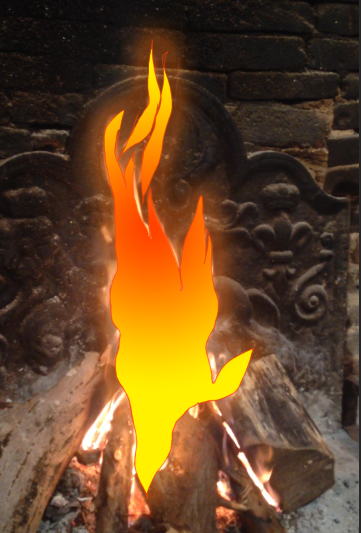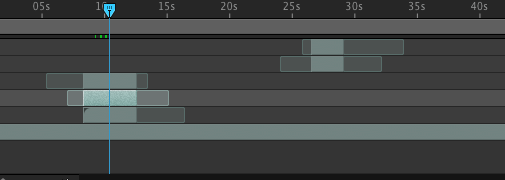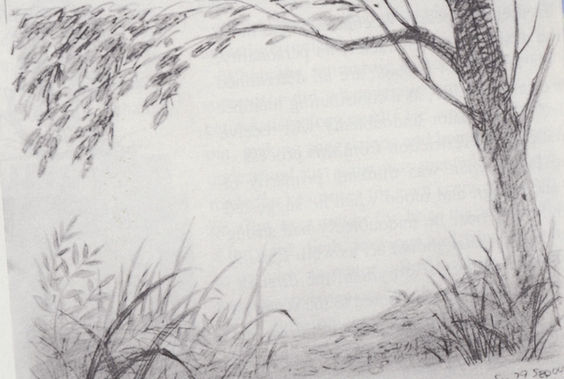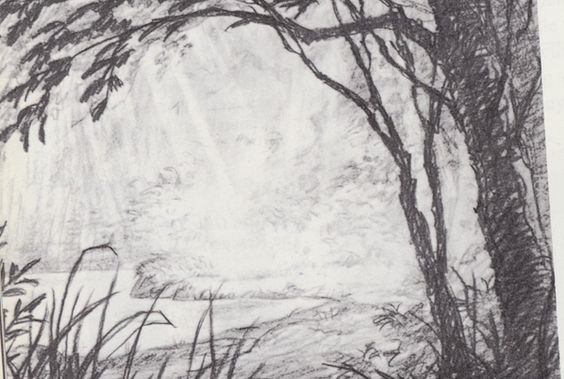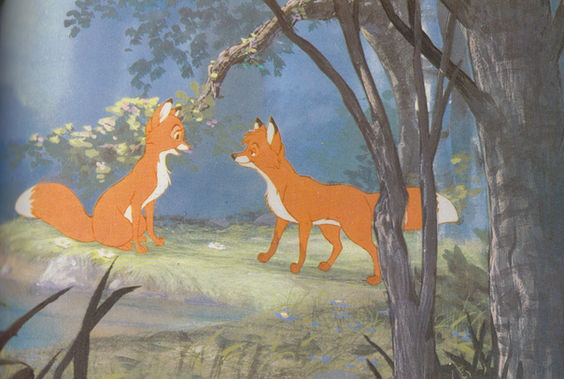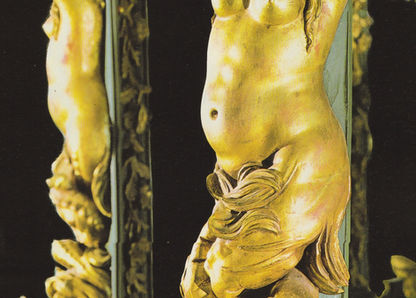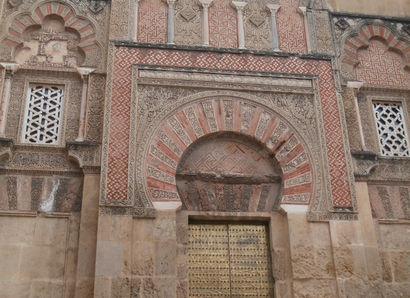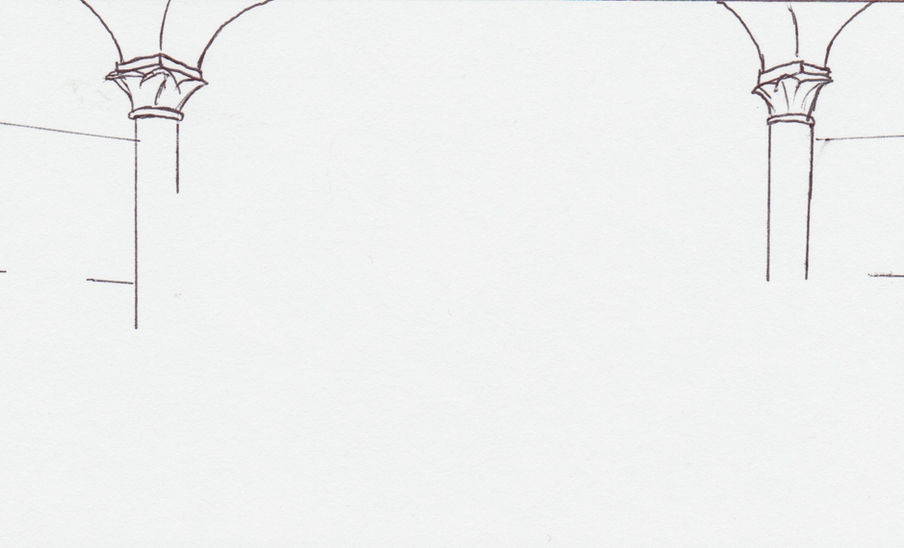top of page

Negotiated Project Semester 2
After the animatic was looked at by staff, there was a point where they were particularly invested in, apart from the fact that it had too much squeezed into 90 seconds.
Staff were intrigued by Esperanza's backstory in which the oppressive Caprichos cult executes people, Esperanza watches in horror as her father fights off an enemy knight and lastly, her guardian carries her out into the wilderness. However, by focusing on the action for three quarters of the animatic, the prologue wasn't clear enough.
Questions were asked as to what happened to Esperanza's parents and their part in the subplot where the Caprichos cultists kill innocents, whether or not the public were on the Caprichos' side and what became of Esperanza's parents.
Expanding
It was decided that Esperanza's backstory should be started from the ground up and the trailer be forgone for actually animating the story in the flesh. The prologue had gaps that needed filling in to explain things clearer and give coherence. For the sake of efficiency, post-it notes were used to bridge the gaps last semester's storyboard had left.

One note shows the victims brought by cart to their execution and the crowd baying for their deaths. Esperanza's mother, Isabel, putting her to bed shows that she is a caring and loving woman. When Isabel is with her husband Antonio Lopez de Vivar, she is the one who persuades him to take action against the Caprichos. Don Antonio de Vivar is not on their side but shows reluctance to get involved in the situation that he somewhat believes will eventually subside. Soon Don Antonio agrees to fight back at the oppressive Caprichos, hiding his identity under a knight's helmet.
Because the Caprichos were inspired by the Spanish Inquisition, Esperanza's parents aren't able to keep their involvement a secret for long. This leads to Antonio having to fend off Don Hernan Hierro, a knight who will become Esperanza's archenemy years later.
Watching her father defend her and Isabel against an enemy knight shows her that the danger comes from her own kingdom, which terrifies her considerably.
What was missing from the animatic was something that would drive home the tragedy, so this was the chance to include Isabel unable to make it out and stabbing herself. By then Esperanza only has her guardian Maria, who is carrying her on a donkey across the mountains.
It would be a better idea if the animation actually delved into the story rather than do an animatic of a trailer.
Traditional visual execution of any animation form follows storyboarding, then a mock-animation in the form of either pre-viz (3D figures in a digital environment) or an animatic, then a fully rendered animation. To put together a trailer from an animatic would complicate the process compared to actually building the story from the ground up.
Characters

Don Antonio de Vivar is a proud, passionate and haughty man who has mainly fought the quarrelling lords around his kingdom to keep the peace on behalf of the new monarchy. The fact that the Caprichos cultists are in the king and queen's good graces leaves him hesitant to fight for the subjugated minorities. It takes Isabel's persuasion to motivate him to fight the cult in disguise, but when the authorities find him out, he must fight to defend his family. His fate is left ambiguous for the sake of the story's future.

Isabel Lobo de Vivar is Esperanza's mother, a sophisticated lady of the manor more capable of tact than her husband and a loving parent, actively took underground action against the oppressive Caprichos, willing to give her life and risk a charge of treason if it meant fighting for the rights of other cultures. By giving away troop movements to the Mura and other rebel movements, Isabel is wanted alive by the Caprichos, forcing her to kill herself.

Maria starts off as the maid of the house, helping Isabel in looking after Esperanza in particular. With Esperanza cut off from her parents, Maria is all she has as a guardian. Once they get clear of all the violence and reach the safety of a mountain village, Maria has to raise the little girl who will become the guardian heroine.
Before Maria, the earliest idea for Esperanza's guardian/foster parent was going to be a wizened old man, probably a monk. Of course they were still going to live together in a remote village. However an old fatherly man adopting the heroine was in danger of becoming tired and tropey. Furthermore not all adoptive parents have to be elderly. When Esperanza is an eight year old girl, Maria is roughly in her late teenage years or near 20. So when Esperanza is about 20 and on her way to becoming a fighter, Maria is either in her late 20s or early 30s.
Part of Esperanza's characteristics includes a fun-loving side, which reinforces the closeness between her and Maria, sort of like an auntie.
For warmup exercises in terms of visually defining Esperanza as a little girl, different sources were looked at. Warner Bros Animation had Wonder Woman as an eight-year old girl in the 'Justice League Unlimited' episode 'Kids Stuff' and a flashback of the heroine Huntress orphaned at childhood when a crime lord assassinated her parents. As 2d animated characters designed by visual artist Bruce Timm, young Wonder Woman and Huntress have bigger, more circular heads and wiry bodies, differentiating them from taller, stronger adult heroes and heroines. The simplified facial details like the enlarged eyes, short noses and big mouths give animated children much emotional freedom. Kid-Wonder Woman tends to be wide-eyed and energetic whilst the charisma of her adult self is translated to the 'bossy little sister' attitude. Huntress, a statuesque, seductive heroine, watches her parents' deaths, paralyzed in fear and scarred for life, moulding her into a brutal, rebellious young woman.
After animation, it was time to use observational skills to add some nuance to little Esperanza. A childhood favourite featuring a pre-teen heroine was Danny DeVito's 1996 film adaptation of Roald Dahl's 'Matilda.' Then-child actress-now writer/storyteller Mara Wilson did justice to Dahl's story because she was so passionate about the role of this neglected child looking for love and acceptance in a world of unappreciative, uncaring parents and teachers. So Mara's likeness was ideal for this little girl who will become a fierce, powerful warrior woman. Her emotional range truly carried the Dahl-based adaptation, no small feat, so as the title heroine, Esperanza should be emotionally open, possessed of her father's energy and zest, but also her mother's heart and intellect.
As a matter of fact, Matilda benefits from Miss Honey, a bright young woman rather than a wise old man who becomes her foster mother in the end after Matilda's biological parents give their daughter away. Coincidentally, making Maria the housemaid the heroine's only surviving guardian gives Esperanza the type of mentor that would break the mould like how Roald Dahl did by giving Matilda Miss Honey.


For real-life inspiration, Spanish princess Leonora of Asturias was looked at. As a royal, she dresses elegantly but freely, unfettered by finery. She also smiles a lot, which can make Esperanza accessible and help you feel for her when all that happiness is ripped away from her by the Caprichos and the soldiers. Full photos of Leonora provided observative research on how Esperanza should be proportioned. Matilda. (1996) [Film] Hollywood, CA. Danny DeVito.
'Justice League Unlimited.' S01E03 'Kids Stuff' S02E06 'Double Date' Cartoon Network. (2004-2006).
hellomagazine.com. Spain's Princess Leonor and Infanta Sofia's matching style and sweet sisterly moments. Hello!, Royal and celebrity news. Accessed 22/02/19 Available at: https://www.hellomagazine.com/royalty/gallery/2018040969331/spain-princess-leonor-infanta-sofia-style-sister-moments/1/


So with this range of inspirations, it became clearer how this female warrior would have started life as a child. She would have been brought up in the comfort of a castle, taught the responsibilities and expectations that come with life in the aristocracy. Of course because of her father's vivacious spirit and her mother's tactful conscience, Esperanza does find herself caught between the wish to indulge in the adventurous life and the will to lead others.
Eventually as her life takes several turns and gets lonelier, Esperanza must summon the courage to stand on her own two feet, train in the arts of combat and face those who have outlawed her, her family and other cultures.
Developing the Caprichos
Animation tutor Omid provided some fresh advice when it came to showing how high the stakes were in this swashbuckling story. The main trick was to show the scale of the oppression and suffering Isperia was going through and how much of a threat the bad guys were.
To develop the Caprichos as villains, there had to be more scenes where they harmed others. They are already shown at public executions, lynching and threatening people with swords.



Due to the Spanish Inquisition inspiration, artwork by Fransisco Goya was looked at for more ideas on fresh background. One particularly iconic painting of his, apart from 'Sleep of Reason,' has to be the painting of an inquisitorial trial taking place. The accused man made to wear a ridiculous hat and tabard has his head bowed in what seems to be fear and submission as leering clerics and councillors discuss his punishment. Visually, the whole trial seems to be against the victim with quite possibly no sign of defense lawyers or anyone who would be on his side. The Inquisition was notorious for forcing suspects to confess and keeping anyone close to the accused from attending should they try come to their defense. In some way, their trials seemed like a precursor to the Soviet show trials in which thousands of people were also unfairly judged and made to confess to crimes, evidence or no evidence, then purged as enemies of the state.
Caprichos Ceremony ideas
Another way to flesh out the Caprichos was what type of rituals they could perform. Little things like that could get people thinking and asking questions as they want to find out more about the story itself. Looking back at the Ku Klux Klan, the flaming cross ceremony has become a symbol of white supremacy and religious extremism. This was something I felt could be used to make the Caprichos so scary, the audience would have good reason to hate and fear them.
The flaming cross wasn't a Klan tradition by origin. It started off as a beacon among Catholic Scottish clans called 'Crann Tara' in which crosses were set alight as a call to arms.
So powerful was Crann Tara, author Sir Walter Scott included its symbolism in 'The Lady of the Lake,' his romantic poem about Scottish clan warfare.

In 1905, author (and white supremacist) Thomas Dixon Jr. wrote 'The Clansman: A Historical Romance of the Ku Klux Klan' to dramatise the events of the post-Civil war 'Reconstruction.' Historically, the Reconstruction is when the Union government tried to mend society for white and black people and achieve racial equality. But a band of white southerners calling themselves the Ku Klux Klan started to attack freed slaves and the Union military with terror tactics and night-rides.
Dixon Jr. T. (1905) The Clansman A Historical Romance of the Ku Klux Klan. University Press of Kentucky. Lexington, Kentucky



(2006) 'Aftershock - Beyond the Civil War' History Channel
This Reconstruction-era Klan wore crude, gruesome masks made out of loose materials or burlap sacks, some (probably the leaders) adding horns to their masks. Riding through the night in sheets and gruesome masks gave Klansmen the pretense that they were the ghosts of dead Confederates coming back to haunt frightened black families who had once been slaves. However there is no evidence that this Klan ever performed flaming cross ceremonies. But instead of portraying them as the criminals they actually were, Thomas Dixon Jr. made them the heroes. In 'The Clansman,' they wear white robes and masks and ride horses draped in trappers like the ones medieval knights rode to war on. Dixon justifies killing black people and Union politicians and champions social inequality by portraying black men as lusting after white women. Dixon had in truth villainised those who supported civil rights.
The Sir Walter Scott and medieval knight inspiration must lie in the white robes emblazoned with crosses, horse trappers and the masks. It is likely Thomas Dixon Jr.'s Scottish heritage inspired him to have his fictional Klan perform the 'fiery cross' ceremony. In this illustration by Arthur L. Keller, Klansmen are gathered around one lifting a flaming crucifix. Through the white Templar-like robes and the way the crucifix is raised like a sword, Keller evokes the crusader knight about to embark on a heroic quest to fight the impure and impose Christian righteousness.


In 1915, 'The Clansman' was adapted to film in what would be the earliest Hollywood blockbuster, 'The Birth of a Nation.' Director D.W. Griffiths made possibly the first ever film to feature big-scale storytelling, epic battle scenes and filmmaking techniques like cross-cuts and angle shots. To a 1910s audience used to seeing onscreen variety shows and comedy like Buster Keaton or Charlie Chaplin lasting around 20 minutes, a romantic, action-packed 3 hour-long film was revolutionary. It is by Griffith's technical pioneering that we have bigger and better films with spectacular production today.
But all this came at a price; 'Birth of a Nation' replicated the same historical inaccuracies, toxic racism and damsels in distress from the novel it was based on. D.W. Griffith followed Dixon's noble depiction of the Ku Klux Klan pretty much to the letter, right down to their knightly appearance and the use of flaming crosses.
Griffith, D.W. (1915) 'The Birth of a Nation' [Film, Black and White, Silent] Natchez, Mississippi. Hollywood, California
Lee, S. (2018) 'BlacKkklansman' [Film] Blumhouse Productions, Legendary Entertainment, Ossining, New York
In this clip from 'BlacKkklansman,' Spike Lee, an African American himself, demonstrates the rather demeaning social effects 'Birth of a Nation' left upon black people whilst empowering the Ku Klux Klan to a social status among American society. The wizened black rights activist recounts to young college students the violent, gruesome death of a black teenager by a white mob who put him on trial for raping and murdering a white woman. Apparently 'Birth of a Nation' had played a part in reviving such violent treatment of African Americans. The Klan in this scene, including the portly woman (married to one of them) boo and laugh at the black characters who are mainly performed in blackface (the wife imitating their stereotypically phonetic accents) and applauding then chanting "White power" when the Ku Klux Klan terrorise and slaughter the black characters.


Being the box office success of its time (whilst making social life worse for black people than it already was), 'Birth of a Nation' coincided with ex-clergyman and veteran of the Spanish American war, William Joseph Simmons, reorganising the Ku Klux Klan into a white supremacist, protestant, all-American fraternity. Simmons heralded the Klan's return by lighting a cross atop Stone Mountain in Georgia. D.W. Griffith's film seemed to have made its way into reality in terms of the white robes and pointed hoods to symbolise all-white Christianity and the flaming crosses that have carried on through to this day.
Brummel, B. (1998) 'The Ku Klux Klan: A Secret History' [Documentary] History Channel. Termite Art Productions.
Klansmen interviewed by reporters from History Channel claim that setting alight a cross isn't "disgracing God" but showing the "light of Jesus Christ" coming "out of the darkness," said darkness being the new modern world they live in. What's more, the few splinter Klan groups have entitled themselves names like the 'White Knights of Mississippi' and the 'American Knights of the Ku Klux Klan.'
That the most infamous criminals and terrorists use motifs so rooted in medieval Christianity is a fact simply charged with irony. To the less progressive, the crusading knight embodied chivalry, therefore all that was good and pure, but those who learn their history know better. The real life knight in shining armour tended to be violent, usually cruel and even foolish. Knights harmed Islamic people and others who worshipped creeds different to their own. They were also responsible for the murders of Thomas Beckett, the unarmed Archbishop of Canterbury and the Cathars (also Christians) at the French town of Carcassonne. In fact Spanish author and satirist Miguel de Cervantes brought the knight in shining armour's failings to light with his novel 'Don Quixote' in which an eccentric crank has delusions that he must go on a quest for his lady and starts charging at windmills, slaughtering sheep and saving dangerous convicts he thinks are innocent. So in a way the Ku Klux Klan take after the knight in shining armour in the hope of projecting the same purity and chivalry portrayed in storybooks, when actually they channel the same backward, violent traits of the knight of real life.

A ceremony like the flaming cross could remind audiences of the Ku Klux Klan and get them thinking of how wicked the Caprichos are.
However God and Jesus aren't part of this fictional universe I have personally created. Tolkien's Middle Earth has the 'Valar,' Morgoth and Sauron, whilst George Lucas's 'Star Wars' has the Light side and the Dark side of the Force.
The 'Dragonlance' series by Laura and Tracy Hickman has gods and goddesses of its own. But the closest equivalent to God in my world would be the 'Celestials,' based on angels. In fact, the idea of a 'flaming sword' had cropped up in recent research.
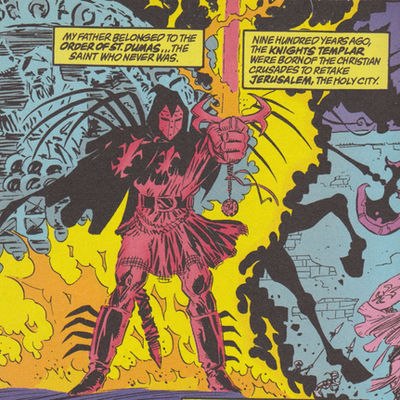
http://www.wisdominlight.com/angels-2/archangels/archangel-uriel/
Moench, D. Manley, M. (1994) 'Batman Knightfall Vol 2.' DC Comics. PR Donnelley, Willards, Ohio, USA. 1700 Broadway, New York, NY 10019. pp. 72, 392, 394
A flaming sword is a popular motif in biblical writings and has been carried over to fantastical storytelling. The angel Uriel used a flaming sword to keep the expelled Adam and Eve away from the Garden of Eden after Eve grew tempted by a serpent to eat an apple from his tree. Uriel's many other names include Azrael, which DC Comics uses for a storyline in its Batman run. In the Knightfall story arc, Bruce Wayne, the original Batman, is so brutally injured in battle that the burden falls on one of his trainees, Jean Paul Valley. Unfortunately Jean Paul was affected at birth with hypnosis by the Knights Templar order. In his visions, Azrael the Avenging angel appears in sinister amour brandishing a flaming sword and ordering him to deliver a brand of merciless justice to Gotham city's criminals. With Bruce Wayne (the Batman who never kills) out of action and Azrael's calls for vengeance, the Jean Paul Valley Batman fights crime through incredible violence, deciding 'the end justified the means.'
The Caprichos' main intention is to bind together the whole of the embattled Isperia. They want to convert this disparate kingdom to an unyielding world power by enforcing absolute dedication of the common people and wiping out all manner of enemies within and without, even those of different beliefs, the 'heretics.' The Spanish Inquisition and the Ku Klux Klan of the 1920s (under William J. Simmons) shared a similar goal, despite the Inquisition being Catholic and the Klan being Protestant. In either case, the flaming sword of Azrael can act as the Caprichos' icon.
Animating the Flame
The plan was simple; to animate a flame, save it as a video file and import it onto Toon Boom.
First in this gallery is the fireplace filmed on my iPhone, then on Photoshop. With the playhead dragged through the footage, a flame was drawn over each flame until they all constituted a whole animation, which is known as Rotoscoping.
The flames needed to be drawn in video layers that run as a recording when Play is pressed in Photoshop's timeline. Drawings were lined in orange with the tablet, making sure each gap was filled, then the interior was selected with 'Magic Wand' and filled with a yellow and orange gradient.

To make the flame luminous, the 'fx' button was selected under the layer. In the Outer Glow dialogue box, the drawing was made to radiate transparent orange.
Photoshop hadn't quite worked as animation software when trying to animate characters and action scenes because it lacks the Onion skinning and lip-syncing possibilities Toon Boom boasts. But it works just fine for animating special effects because effects don't have to be lip-synced with anything and can just be added to previously animated footage.
After animation and colouring was finished, the flame was rendered into a Quicktime video that could be imported as footage.
The real issue was trying to import the flame video onto Toon Boom. Instead of importing the video into the timeline as a single moving drawing, the process chopped the track into individual frames. There are several flames apart from the statue's sword, because the Caprichos cultists hold flaming torches to make them look more menacing. This would require replicating the flame and moving them to different parts of the film when it was submitted.

Another attempt was to save every frame (over 200) as PNGs. These were saved in a separate folder and Omid instructed me to import all of them into Toon Boom as an 'image sequence.' But the version of Toon Boom I was using, 'Harmony,' had no option to 'import an image sequence.

Despite Omid saying that keying the flame onto After Effects would be more of a headache than if I were to import it onto Toon Boom, no other way to pull off the latter could be found.
Instead both the film and the flame were imported onto After Effects with the flame layer placed on top of the film in the timeline.
Chroma Keying was practiced in Year 1 back when I had dress up as a ghost in front of a green screen then keyed myself up against photos of my house and the neigbouring church graveyard with After Effects. Now I was going to do the same to an rotoscoped flame up against an animatic. But just like last time in Year 1, what I was keying in needed a bright colour that could be keyed out. It had taken a fair amount of pressing as many buttons as possible, but selecting the 'Colour Difference key' was what removed the box of red background and left the flame. What makes After Effects so effective is that it can not only import footage as a full sequence, but it also lets you remove certain colours that can disrupt the film.
After keying, the flame was duplicated in the timeline, then each copy was moved around at different stages of the film and lastly placed wherever there were to be the lit torches and the flaming sword for the angel statue. The flame that would be the sword had to be stretched thin to look like a sword blade.
Adding flame effects to animated footage is what I hope to be just one of the breakthroughs of this year. Rotoscoping from real-life elements like I did with the fireplace could show animation studios my creativity if they would like realistic special effects.
Although Omid had warned how hard keying would be, I couldn't find any other way to import the flame via Toon Boom, so some hard decisions had to be made. But I think After Effects was more adventurous and previous experience with keying made it all the more encouraging.
Hand-drawn backgrounds
Drawing the backgrounds (buildings and other scenery) on the tablet had once been tried in the last couple of Animation modules. But compared to drawing live characters, on a technical and aesthetic level, drawing a digital background wasn't satisfactory. Digital lining was too clean and unbending to do justice to the detail. The 2d animated characters needed to stand out against the background and they might get lost in the digital layer behind them.
Thomas, F. Johnson, O. 'The Illusion of Life Disney Animation' pp. 184, 187, 227, 324
To come up with more painterly, stylish backgrounds, the ones used in Disney animation were looked at. On a multilane camera, celluloid sheets from the older classics were filmed on panels above the background sheet so that they simply acted up against the environment. Simply put, my digitally drawn characters have to act up against an environment of their own, except now we use Toon boom software in place of a multiplane camera these days.
Backgrounds used by Disney's animation studios were almost as lavishly painted as any classical painting one could find in a gallery. The first one of the melted candle would have been used in Cinderella. It works like a sort of stage backdrop in theatre one would find set behind the performing actors, painted on or made from actual props. The design is richly painted with the waxy texture, the metallic sheen and the shading with a sense of believability adequate to the stylised character cels.
The next couple of images show the process of illustrating the backgrounds. These start off as sketches where the lining is roughly applied before shading and crisp details are added in.
The still from 'Peter Pan' shows Captain Hook acting up against the ornate, ostentatious backdrop of his ship. The designers have applied the excess of red and gold adornment that would fit the whole pirate theme. Composition, an important component in illustration, matters also in animation. Hook dominates much of the right of the still, but is sized according to the staging the storyboard would have mastered. It's the same with the still from 'The Fox and the Hound'. Not only are the characters placed in this forest environment, but some extra background elements have been added over the character plates that convince us that these hand-drawn foxes are actually surrounded by forestry. In this way, we believe the characters to be interacting in their hand-drawn environments.
Book page scans
Architecture photos taken on location
Landscape photos taken on location
Hintzen-Bohlen, B. (2013) 'Andalusia, Art and Architecture' Ullmann Publishing, Potsdam, Germany. pp. 20, 91
'Kings of Spain'
Coming up with my own non-digital backgrounds needed a sense of aesthetic if this was a fantastical kingdom inspired by medieval Spain. Spain is a mediterranean country with buildings somewhat echoing the Roman imperial design with the terraced roofs and beige brickwork. Integration with the Jews and Moors added an Islamic and eastern influence with arches, geometric patterns and Kufic calligraphy. There needed to be cityscapes to show where Esperanza and her parents live, a plaza where victims are publicly executed and the mountainous, arid landscape when Esperanza and her family maid Maria get away from the Caprichos.
Because we are shown Esperanza as the warrior woman in adulthood before the flashbacks, it was envisioned she would be standing on the edge of a cliff with a forest behind her, because she is on a journey through the wilderness. The plaza is based on the one visited at Salamanca because of the baroque design of the arches and pillars. Some of the scenery like the trees use the crooked lining and sketchy shading take a leaf from Goya's haunting aesthetic. The city Esperanza is from was inspired by a mix of personally taken photos and book scans of Seville. Seville is one of Spain's most impressive cities with enough architecture and history to get inspired. 'Andalucia art and architecture' is a small handbook featuring additional aesthetic like murals and historical artwork.
Before drawing the backgrounds, stills from each scene were screen grabbed and printed. Then over a lightbox, background elements were traced in pencil on another sheet and lastly the pencil lining was traced in pen. Pencil lining lets you make mistakes that you can rub out. Inking the drawings takes confidence and unless you're confident, mistakes made in pen lining are likely.
Because hand-drawn animation is now accomplished with Toon Boom software, inventions like the multiplane camera has passed into animation history. The background sheets were scanned in and the backgrounds were imported onto Toon Boom. The background layers were placed under the animated layers so the characters act up against these drawings of buildings, walls and countryside.
Using inked backgrounds rather than tablet-drawn seems to have added nuance to the animation. The lining is less intrusive than it would have been had it been digital. It works particularly well when Esperanza is standing up against the pine forest and sitting on the windowsill of the cottage she and Maria now live in, as the freedom pen lining affords complements the tranquil tone
and the when the torture takes place in the gloomy dungeons.
However there have been some instances where the background have inadvertently been imported as Vector images instead of Bitmap files. The grey shaded lining turned into bold black, so the audience might be confused as to where the characters are.
Gary Trousdale, Kirk Wise. (2001) 'Atlantis: The Lost Empire' [Film, Animated] Walt Disney Feature Animation. Buena Vista Pictures.
Sam Liu. (2016) 'Batman: The Killing Joke' [Film, Animated] Warner Bros Animation Studios. DC Entertainment.
Even in today's 2D animated movies and shows, artists treat the environments separately from the hand-drawn characters. Lining is not as sharp as those of the characters' so unless the artists used very thin, smooth lining on a tablet, they may or may not have scanned in ink drawings. In the 'Atlantis' clip, the subterranean caves, stalgamites and monuments would have taken some painstaking detail and an illustrator's steady hand. Of course being animated in the early 2000s, it is likely the muted colours and rocky texture would have been applied digitally.
Whether the cityscape in the opening of 'The Killing Joke' was first drawn on a sheet then enhanced on computer or not is debatable. But it is pretty obvious that the glow of the windows and streets, the shading and textures like the reflective window panes are digital, seeing as how the movie came out in the 2010s.
Should I get into the animation industry tackling backgrounds, I could colour them with Photoshop and add special effects like how I did with the flame. Obviously engaging audiences with the environment the characters are set in needs good drawing skills as much as the characters do.
Developing the Story
A screening of the animatic for Omid and Jaime earned praise for fleshing out the story. However Jaime wanted everything in the story to connect, from Esperanza standing on the cliffside, through her childhood in which she loses her parents, right up to when we cut back to her on the cliff. What all these stages in Esperanza's life and character development needed was one unifying story detail that would tie all of them together. This advice would enhance the animatic from a storytelling standpoint, so it needed addressing.
Fortunately there is an element already considered that could be used as a motif. Back when she was first drawn, Esperanza wore a gold medallion with an emerald in the middle. As the story was being written, it was her mother who first wore it. If there was ever going to be a situation where Esperanza ended up having it, that would be when the threat of the Caprichos looms over them.

The first image is how Esperanza originally posed. This was changed to the second image, where she would put her hand to her chest where her medallion is worn. With that issue addressed, additions were made to the flashbacks. When family are found out plotting against the Caprichos, Elena cups Esperanza's chin and places something in her hands, just before killing herself to deny the villains of a prisoner to interrogate. In the part where a 20 year old or late teenage Esperanza is living in the small village, she is wistfully sitting up against a window looking out at the mountain view. Here I had her look down at her mother's medallion in her palm before looking back out at the view.

To close off the animatic with the connection in the medallion, we have Esperanza wearing her armour can cape gazing nostalgically at this heirloom. If you notice in the above images, Esperanza's pose on the window as changed. Having her sit on the floor didn't exactly click because this moment is over 10 years after she lost her parents. Instead she sits on the windowsill delicately cradling the medallion in both hands.
So here I had exercised my techniques as a storyteller by binding events together with a unifying detail, and edited a character pose I felt wanted correcting.
Animation studios deal with storytelling through visual arts, so narrative and editing techniques might get me doing an animation-related career. Being able to backtrack and improve my work shows how an eye for detail can achieve better results than if I were to stick to the original idea.
Animating drawings
In the time I had to flesh out Esperanza's backstory, there were attempts to animate it so it could at least look finished, or at least like there was some progress made. One part I truly focussed on was getting Esperanza's hair and her cape to flap in the wind in the beginning scene.
The key to animating hand-drawn characters is to put together as many drawings of said character until the movement is slick enough to become believable. But if the character stays where they are, there is less need for more drawings so the animator can focus on the character's mouth, hair or any other visual feature.
Ron Friedman. 'GI Joe A Real American Hero' - 'The Revenge of Cobra' [TV pilot, Animated] (1983 - 1986) Sunbow Productions, Hasbro Studios. September, 1984.
Sander Schwartz, Joseph Barbera. 'What's New Scooby Doo? - Riva Ras Regas' [TV episode, Animated] (2002 - 2006) Warner Bros Animation. Cartoon Network, November 2002.
Glen Murakami. 'Teen Titans - The Apprentice Part 1' [TV episode, Animated] (2003 - 2006) Warner Bros Animation. Cartoon Network, October 2003.
Even back in the 1980s through the early 2000s, the 2d characters only move when performing a particular action. More drawings are necessary for fight scenes, walking, chasing or making gestures. In the GI Joe clip, Roadblock wrestles Cobra Commander then beats up his guards. In a clip from the more modern iteration of Scooby Doo, Scooby bounds after a suspect with his friends in tow. The Slade-vs-Robin fight scene would require a lot of drawings to get run action, but the time it takes for someone to leap or punch doesn't always necessarily mean this.
If standing still or staring, there is little need for a character to move about, therefore the strategy is to keep the character drawing as it is and concentrate on whatever gesture, facial feature or other visual element is used to express the characteristics.
When Cobra Commander orders his prisoners away, he points angrily at Roadblock and the cowgirl while his guards stand watch with guns at the ready. The GI Joes shake hands, so all that's needed is to move their arms.
Scooby Doo and Shaggy listen to Fred getting speaking with the suspect in the sauna, they sit where they are blinking as the interrogation goes on.
When Robin sees himself as Slade, all he does is stare in horror. The camera zooms in on his face, providing a sort of motion that underlines the sudden shock of where Robin's nightmare leads to.
It seems the tactic to keep a character drawing as it is and minimising the need for more drawings comes from the fact that whilst studios like Sunbow (now defunct)
and Warner Bros (an animation powerhouse to this day) has or had a generous budget, they are not quite on the same level as Disney's studios that produced a whole line of 2D animated films before moving on to 3D and Ghibli that is best known for its anime like 'Princess Monoke' and 'My Neighbour Totoro.'
Despite needing to limit its character drawings, some 2D animation studios can still carry the story through prioritising features that make all the difference visually.
Esperanza's wistful expression could be kept the same, but her hair needed to be divided into several drawings. In the timeline, the drawing was selected and 'Copy Drawing Object' was selected from 'Edit.' Next a frame was deleted in the drawing's track, splitting the track. In the empty space, after selecting 'Paste Drawing Object,' the copied drawing was placed alongside the original. As the screengrabs show, copying and pasting the drawing object divided it into editable versions. In each one, Esperanza's hair, cape and the cult leader's arms and body are drawn into a sequence of individual images. The Onion skin benefitted the process a lot, because it helped gauge the distance between the previous drawing (shaded in red) and the next (green) so the one I was working on could be drawn in consistence with the flow of the animation. Animating on Photoshop in previous assignments were hardly as efficient due to lacking the advantage of the onion skin. If I am to make a profession of 2D animation, the industry would likely expect me to use the use a sophisticated software like Toon Boom rather than sticking to Photoshop.
Concierto de Aranjuez - Esperanza Backstory - Joaquin Rodrigo
00:00 / 00:00
Music
The intention of the classical 'Concierto de Aranjuez,' had been to give the animation that sense of epic, romantic and tragic feeling that comes with this backstory where the main heroine has lost everything in her youth.
But the criticism Omid and Jaime had for the choice of music was that classical music didn't feel right with an animated epic story. At its heart, the story of Esperanza has its roots in the fantasy blockbuster, and the tutors weren't entirely convinced that classical music, no matter how famous or magnificent, flowed very well the the animated storytelling. Looking back on the choice, it was also clear that the swelling, strident violins and horns of 'Concierto' sounded too separate from the action and character interactions.
Omid and Jaime recommended film soundtrack. At first the score for the 1960s 'El Cid' starring Charlton Heston was considered.
Miklos Rozsa's orchestral score for the medieval epic has some majesty to it. But the video I intended to set music to lasts 90 seconds. For something that short, the trumpet/strings score of 'El Cid' sounded a bit drawn out. What's more that film lasts about 3 hours and time was pressing.
James Horner's score to 'The Mask of Zorro' is a score I already listened to, mainly because I have watched this film for several years. Knowing the soundtrack inside and out meant it didn't take long for me to pick which track should be put to where. This task was performed on Adobe Premiere.
Like Omid and Jaime said, the music had to tonally fit with what goes on in the animatic. 'Leave no Witnesses' is played in the film's climactic battle and tension ramps up in the beginning. Instead of the high, emotional strings of 'Concierto de Aranjuez,' it starts with sharp, haunting flutes and foreboding strings that accompany a sense of impending danger. That would go well with the scenes where the Caprichos are oppressing the country.
The more tender violin part, just before the tension truly kicks off, was deemed most suitable for the part where Esperanza's father kills a number of Caprichos. Had it been any longer, music to that part would be more action-packed and exciting. But wrapping up that part along with the intro to Esperanza and her family up to the part where the father has undermined the Caprichos and returns home safely would give the feeling of hope and respite from the oppressive, lingering peril.
By the time Esperanza's family is attacked by the Caprichos supported by knights and soldiers, that is when the music grows louder and even more menacing.
'The Confession,' a tender and romantic cue was picked for the relatively tragic conclusion where Esperanza is taken to the safety of the village and grows up with only her family maid for company. This track felt wistful enough to fit Esperanza's feelings of loss, particularly the nostalgia she experiences when gazing at her mother's medallion. To close off the film smoothly, the light guitar strings added at the end when we cut back to Esperanza in her armour and cape still holding onto her medallion, her hair gently flapping in the breeze. Although gentle like Horner's score, 'Concierto de Aranjuez' didn't have as much variation in notes or as much flow in comparison.
This challenge to improve the film's soundtrack proves that as the mastermind of an animated story, I have to ensure the music lives up to everything communicated by that story. Hypothetically, when I got Joaquin Rodrigo, a classical composer, to conduct the soundtrack, but it doesn't flow with the action and sense of drama. But by turning to James Horner, a film composer, I get a soundtrack that hits the right notes. In a professional situation, I would have to hire a composer able to know the right beats and tempo to compliment every scene in a film or like the first track I tried to use, it may cause audiences to feel lost when watching it.
What we have here is an animatic chronicling a kingdom's descent into tyranny and a young girl's destiny to take her parent's place in the fight the murderous cult. Showing what happens in the story clearly was a priority but there was some room for line tests like animating hair and cloth. The donkey gave me the chance to be adventurous and do a walk cycle with a four-legged animal. Not all of the details like the crowd waving their fists or the figures still drawn in basic shapes got finished, but hopefully they aren't too glaring. Omid and Jaime's suggestions benefitted the story and the execution of the animatic. The music flows better with everything that happens and the use of the medallion as a link between Esperanza's childhood and adulthood make this more provocative and like a proper film. Previous experience with After Effects and everything I had learned previous years were what encouraged me to do some line testing, background illustration, walk animation and animate flames. This kind of self-dependence might probably motivate me to get involved in professional animation. Some time I also could pitch this new story of mine to a company so it gets animated as an actual film.
bottom of page













